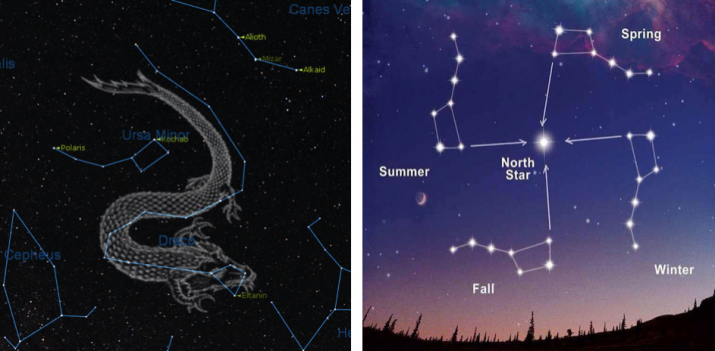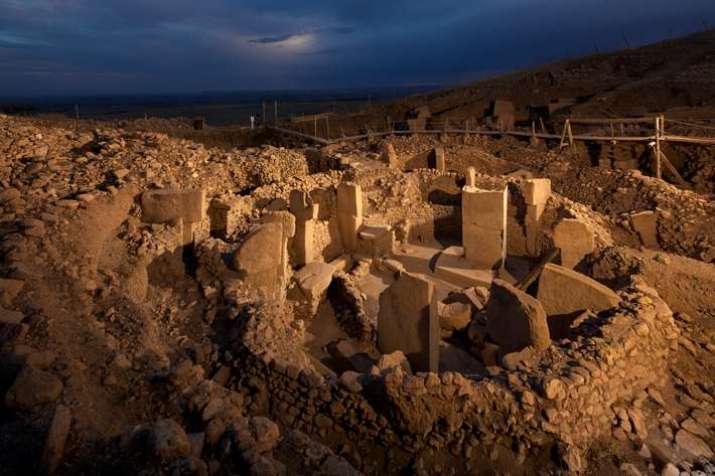FEATURES|COLUMNS|Silk Alchemy
The Iconography of Nagas, Part Four: Chaos and Creation
 The Milky Way. From slate.fr
The Milky Way. From slate.frMy wide swing in this series of articles that examines the expansive history of the naga, and serpent veneration in general, may seem to have digressed far from our Buddhist roots at times. While I have no wish to rehash familiar stories, I have noticed elements beyond local and religious narratives that point to something possibly more temporal and felt it worthy of investigation. Is there a reason the serpent has appeared so frequently in creation mythology and imagery since the beginning of recorded history? And might it behoove us all to heed its message?
I first sought out the very oldest serpentine records, often quite literally written in stone and in each case recounting humanity’s history, and I noted some common themes. So I wonder if these facts and teachings were spread in a way that explains why so many root stories have more in common with each other than not.
I recommend reading my preceding articles in this series to help piece together these elements—in Part Three, for example, I began looking at manifestations of the naga in human form, digging into some DNA history and theories that date the origin of modern humans much earlier than previously thought. Here, for your consideration, I will continue to voyage deep into history and the serpent’s potential role in chaos and creation as an actual memory rather than esoteric Gnosticism or psychology.
Since time immemorial, mankind seems to have looked to the stars, the patterns of which have seeped into our consciousness and our mythologies. The most evident of these is the eternal embrace of our Milky Way, wrapping itself around our world and offering us a wealth of etiological myth and the resulting aitions—from Jörmungandr, the Midgard serpent of Norse mythology, to the alchemical Ouroboros, forever eating its own tail. From the Hydra of the Greeks to Hinduism’s Sheshanaga, holding Vishnu’s reclining self as they surf the foaming crest of an endless milky ocean.
From the Earth’s point of view, this cosmic serpent encircling our “egg” of a planet (alchemy’s Orphic Egg?) appears to hang protectively, opening its jaws toward the Dark Rift in the Cygnus constellation, which was considered the birthing canal of life itself.* A close neighbor in the womb of space, apotheosized by the Egyptians as the goddess Nut, the great mother sky, is the constellation Draco, seen slowly winding around Polaris, our pole star, giving us an annual celestial svasktika (first seen carved in ivory some 12,000 years ago in Mezine, Ukraine, later the Vinca culture of the Balkans 8,000 years ago, and likely why the symbol continued to be used globally until it was distorted by the Nazis in the Second World War.)
 The Draco constellation and the swastika formed by the seasonal rotation of the contellations around the Pole Star. From pinterest.com
The Draco constellation and the swastika formed by the seasonal rotation of the contellations around the Pole Star. From pinterest.comCuriously, around 5,000 years ago, when so many serpentine images were also being laid in form, as in the Neolithic Vinca bowls with their serpentine spirals, our pole star was Thuban, of the same Draco constellation. I don’t doubt that this was one of our earliest observations that found metaphor with the earthly snake.
Over a great measure of time, as our planet cycles around its axis, known as the procession of the equinoxes, a great “wobble” appears to have occurred over a period of some 26,000 years. This phenomenon seems to have been noted by our ancestors, evidence of which appears to have been quite literally written in stone. And as we saw in my first essay on serpent worship, snakes and megaliths seem to have gone hand in hand, and many of these stones have caused much intrigue, awe, and speculation.
Prehistoric megalithic structures have been discovered around the world, including the likes of Sacsayhuamán in Peru, and Yonaguni in the waters off Japan’s Ryukyu Islands, which some estimates put at 8,000 years old. However, even older than the Temple of Jupiter in Baalbek, Lebanon, with its colossal pillars and blocks weighing in up to an eye-watering 1,600 tonnes; and even older than the spread of the Harappan or Indus Valley Civilization, which some archaeologists have suggested dates back some 8,000 years, is the discovery by German archaeologist Klaus Schmidt in 1994 of Göbekli Tepe in Turkey, speculated to be the oldest temple ever discovered.
Intentionally buried after proposed usage of many centuries, sealing its carved symbolic treasures against time, Göbekli Tepe has been something of a gift for historians because carbon dating at the site is remarkably free from organic contaminants. The only wrinkle is that it flies in the face of our conventional understanding of the history of modern humans. This extraordinary site is believed to date back as many as 11,600 years, to the end of the last major ice age—a time when humans are presumed to have been far more primitive. Yet here we have proof of an exceptionally advanced people who created an abundance of refined carvings, their creativity and ability unquestionable. They were able to excavate, place, cut, and carve massive blocks weighing up to 65 tonnes, clearly understood symmetry, and appear to have had knowledge of the stars and their cycles.
Researchers from the University of Edinburgh have proposed that the highly detailed carved symbols relate directly to a deep understanding of astronomy, as does the relative positioning of the pillars to the heavens 12,000 years ago. The symbols also speak of a stellar event that had a cataclysmic result here on Earth, essentially wiping out thousands of species.** The result of comet debris hitting the North American ice caps led to global flooding and a mini ice age that lasted 1,000 years—a time we refer to as the Younger Dryas period and is seen as a streak of dark through rock, known as a “Black Mat.”
 The mysterious Yonaguni structure submerged in the waters off Japan. From jpninfo.com
The mysterious Yonaguni structure submerged in the waters off Japan. From jpninfo.comGöbekli Tepe also lends weight to arguments that ancient sites in Egypt, including the Sphinx, may also be much older than previously thought. While academics such as British Egyptologist David Rohl and other more orthodox historians squabble over the proposed New Chronology of Middle Eastern and European history and the related timeline implications, the nature of Göbekli Tepe leaves little doubt that prehistoric civilizations were significantly more advanced than was previously assumed.
In the Egyptian temple of Horus in Edfu, building texts etched into its walls are chronicles from another epoch. They refer to the pre-dynastic period called Zep Tepi (according to some researchers, a historical period that can be traced to a specific date, 36,420 BCE) and are echoed in the Palermo Stone,* a stele fragment bearing hieroglyphic details of events and rulers that orthodox Egyptologists consider pure myth. The texts describe a great race that was rendered homeless due to a massive cataclysm—described as the “Enemy Snake,” a “Great Fire Serpent” in the sky.
A massive asteroid burning through the sky and visible to all, bringing to an end one epoch and heralding another? Could this explain some creational myths (some of which are referenced in my previous article) about a great cosmic serpent, chaos, and flooding, and humanity created in its wake? For example, China’s legend of the half-serpent mother goddess Nugua; or the snake-free island of Fiji that nevertheless had mythology of a supreme serpent god, Degei, responsible for the creation of humanity in a twilight world of nothing but water, aside from one land of the Gods that was in the far distant horizon.
Krishna dances on the head of the cosmic serpent in defiance, while Markandeya Rishi, an immortal of Hindu legend, was said to have witnessed pralaya, the cyclic dissolution of the universe when all becomes nothing but water before life starts again in a new age. What if this was a romanticized telling of an actual dissolution of the Earth by a global flood? The cycle of the ages, the yugas, are 24,000 years, divided in two, giving us very similar timetables to the procession of the equinoxes and the near-glacial Younger Dryas period. Curious?
Likewise, the Book of Enoch of the Semitic tradition and its “sister” text the Book of Jubilees, some of the earliest religious works discovered, describe Watchers, referred to again, as serpents, who imparted their antediluvian knowledge of the arts and sciences of Heaven.
 Göbekli Tepe in Turkey may be the oldest temple ever discovered. From archaeology.org
Göbekli Tepe in Turkey may be the oldest temple ever discovered. From archaeology.orgIs it possible that survivors of this cosmic “fire serpent” event with their occult wisdom—parallels of which we see in many of the world’s faiths today—were seafaring and shared their wisdom and history with more primitive survivors? Could their namesake be a reminder of the great fire serpent of the sky? And could this be why we see variations on the term naga in diverse parts of the world: Nagal in Mexico, the divine serpent language Naga-Krita of China, and the city of Naga in Ethiopia? And that the naga of Indian and Southeast Asian mythologies are also referred to as serpent folk and said to come from a far-off land in the ocean? Even in Tibet, a land free of snakes, we see the term naga—also known as lu—serpent spirits to be respected. And, interestingly, on a small lake behind the Potala Palace, the former winter residence of the Dalai Lama in Lhasa, lies a hidden temple built by the 6th Dalai Lama, the Lukhang—residence of nagas.
Is this why such images, half snake, half human, so frequently adorn places of sacred reverence? A reminder of these wise cataclysm survivors, considered divine in comparison with the less enlightened? What if this event was embedded into our ancestral stories that then became systems of worship? The chaos and ensuing birth of life; less a genesis and more a regenesis of humanity. And maybe, just maybe, descendants of those original travelers spread and imparted their knowledge to Asia, East Africa, the Balkans, southwest India, the Americas, and beyond, slipping into our language as the snake, the dragon, the naga? Just questions. But if this was the case, could not such an event occur again? If it was catastrophic debris from a passing asteroid (perhaps arriving with the Taurid meteor shower), should we be taking precautions against a repeat disaster on a global scale?
How would we go about encoding today’s knowledge for generations to come, hundreds if not thousands of years from now? In the Kolbrin Bible, texts purportedly written 3,600 years ago and guarded by the Egyptians and Celts, certainly predict that the cataclysmic fire dragon could return. Let’s hope it won’t!
The next and final chapter in this saga of the serpent will return to the more spiritual and subjective experience of the naga in our lives.
* Cygnus is the subject of yet more interesting symbolism as it completes the Aquila constellation—the eagle—reminding me of the naga’s relationship with the winged garuda.
** 12,800 YEARS AGO, EARTH WAS STRUCK BY A DISINTEGRATING COMET, SETTING OFF GLOBAL FIRESTORMS (Universe Today)
See more
Naga and the Buddha (Buddhist Arts)
Related features from Buddhistdoor Global














